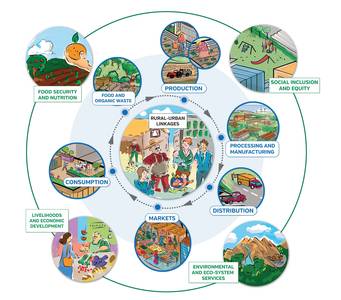The CRFS approach
A city region is defined as: “a larger urban centre or conglomeration of smaller urban centres and the surrounding and interspersed peri-urban and rural hinterland”.
The term ‘city region’ not only refers to megacities and the immediate rural and agricultural areas surrounding them, but also to small and medium-sized towns that link remote small-scale producers and their agricultural value chains to urban center and markets in developing countries. Although contexts differ across cities and regions, urban-rural partnerships and inter-municipal cooperation always extend beyond traditional administrative boundaries. In our approach, we focus on food systems as the functional tie that binds a territory together.
A City Region Food System is defined as “all the actors, processes and relationships that are involved in food production, processing, distribution and consumption in a given city region”.
Additionally, city region food systems are connected to many other rural and urban sectors (e.g. food security, economic development, water and waste management, energy, transport, health, climate change, governance and spatial planning, etc.). By taking this into account, economic, social, and environmental sustainability linkages can be acknowledged.
City-region food system
Adopting a City Region Food Systems (CRFS) approach offers concrete policy and programme opportunities where urban developmental issues can be addressed and rural and urban communities can be directly linked. Improved city region food systems improve economic, social and environmental conditions in both urban and nearby rural areas.
Apart from the involvement of local governments and other actors - the development of a resilient and sustainable city region food system also requires political will, the use of available policy and planning instruments (infrastructure and logistics, public procurement, licenses, land use planning), multi-level and cross-sectional government involvement, (local and provincial) actors from the civil society and the private sector.
In order to support policy transformation and the implementation of a resilient and sustainable CRFS, it is crucial that local governments and other actors assess their food dependencies, identify weaknesses and potential pressure points, and where possible, develop targeted strategies to improve their food systems. Each city region is unique with its own specific characteristics, challenges and solutions.


